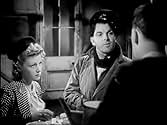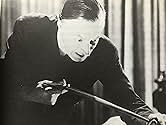A convict, just out of prison, is implicated in a murder and goes on the run, hitching a ride with a truck driver.A convict, just out of prison, is implicated in a murder and goes on the run, hitching a ride with a truck driver.A convict, just out of prison, is implicated in a murder and goes on the run, hitching a ride with a truck driver.
William Hartnell
- Bus Conductor
- (as Billy Hartnell)
Hyma Beckley
- Newspaper Seller
- (uncredited)
William John Davies
- Youth
- (uncredited)
Edgar Driver
- Customer at Charlies
- (uncredited)
Brenda Harvey
- Unknown Role
- (uncredited)
Mike Johnson
- Old Convict Being Released
- (uncredited)
Vi Kaley
- Flower Seller
- (uncredited)
Featured reviews
"They Drive By Night" (not to be confused with the Bogart) had a rare showing in a New York theater in 2009, as part of a series on British film noir. The only reason the theater screening matters is because of crowd reaction. And the reaction to this film, especially the final sequences, was absolutely joyous.
The movie is at least 2/3rds over before one of the main characters appears, the former schoolmaster Walter Hoover, played by the unbelievably urbane, stick-figure-thin Ernest Thesiger. The camera starts on his hands, so you only see what he's doing-- pasting newspaper clippings about lurid murders into a scrapbook-- but when his face is finally revealed, the whole audience seemed to sit a bit straighter, and we stayed that way through the end, reacting with open delight to this character's every movement, his every phrase.
I mean to take nothing away from the star of the film, Emlyn Williams (who wrote almost as many films as he starred in), but Ernest Thesiger was capable of turning a lousy movie into a watchable one, and a good movie into an unforgettable one. This is definitely the latter.
The movie is at least 2/3rds over before one of the main characters appears, the former schoolmaster Walter Hoover, played by the unbelievably urbane, stick-figure-thin Ernest Thesiger. The camera starts on his hands, so you only see what he's doing-- pasting newspaper clippings about lurid murders into a scrapbook-- but when his face is finally revealed, the whole audience seemed to sit a bit straighter, and we stayed that way through the end, reacting with open delight to this character's every movement, his every phrase.
I mean to take nothing away from the star of the film, Emlyn Williams (who wrote almost as many films as he starred in), but Ernest Thesiger was capable of turning a lousy movie into a watchable one, and a good movie into an unforgettable one. This is definitely the latter.
This is a somewhat "lost" film from England in the late thirties. It definitely does have Hitchcokian overtones as a young con just released from prison goes to visit a girl he knew, only to find her dead, and himself accused of the crime. The bulk of the film follows this young man as he tries to hide from the police by traveling North on a lorry(truck). From there he meets a female of his acquaintance, convinces her of his innocence, and they both embark on a quest to find the real killer. The film has a nice, tight directorial style that creates lots of suspenseful moments. The script is also pretty good. The biggest key to the film's success is the acting. Emlyn Williams does a good job in the lead, but acting honors easily go to Ernest Thesiger playing a highbrow, effeminate, erudite former teacher and student of psychology with a deadly secret. Thesiger's character acting is a joy to behold as he talks about the power of killing in one moment and then in another talks to pussycats in a baby voice. He is so wonderful with these kinds of quirky characterizations(a must-see in The Bride of Frankenstein). A good, old-fashioned suspense story.
Taut British noir. set mostly after dark and indoors, about an innocent man on the run for a crime he did not commit (Emlyn Williams), the girl who helps him (Anna Konstam with a blonde perm), not quite a tart but with a heart of gold, and a creepy serial killer (Ernest Thesiger).
Interesting for its inversion of the usual values of 1930s British films, in which the lower classes tend to be either comic or villainous or both. Here the murderer has the accent, the education, the aesthetic taste and the comfortable house while virtually all the other characters share the camaraderie of the working class, which includes a disinclination to say too much to the police.
A number of similarities with Hitchcock films of the period, in particular "Young And Innocent", which also has a falsely accused man and a girl who believes in him trying to find the real murderer in a transport café and a dance hall.
Interesting for its inversion of the usual values of 1930s British films, in which the lower classes tend to be either comic or villainous or both. Here the murderer has the accent, the education, the aesthetic taste and the comfortable house while virtually all the other characters share the camaraderie of the working class, which includes a disinclination to say too much to the police.
A number of similarities with Hitchcock films of the period, in particular "Young And Innocent", which also has a falsely accused man and a girl who believes in him trying to find the real murderer in a transport café and a dance hall.
Nice crime thriller that almost seems like a lost Hitchcock film. Moody lighting contributes to the noirish atmoshpere. Ernest Thesiger turns in one of his creepiest performances.
Anyone who likes film noir, murder mysteries, Hitchcock type adventures about a wrongly accused man on the run from the law or just superbly made 1930s films should watch this.
This isn't set in the care-free, art-deco festooned sunny London seen in most 1930s pictures. This is reality, a dirty smelly reality with real people - at times it almost looks like a documentary but it's not one of those miserable dark and dingy films when nothing happens - a lot happens in this: murders, rapes, kidnapping - plus a bit of comedy to make it palatable. In this it just feels like it's happening to real people making it seem real to you.
For starters, the cinematography is amazing. As film noirs go, this has to be one of the most visually impressive. Expressionism is expressing the feelings of the protagonist through what we see on the screen. Every scene with Emlyn Williams' Shorty is in murky disturbing shadows and as his situation gets worse, that darkness increases and contrasts with the bright lights of Molly's optimism. It's a clever and beautifully made film.
It's a magnificently evocative picture. It immerses you into late 1930s working class life and into London, a proper working class city. A city not of top hats and walking canes but of pubs, petty criminals and prostitutes. We learn there were two groups of prostitutes: dance hall girls (taking their work home) and lorry girls who entertain lonely lorry drivers - those who drive by night.
It's not all darkness however, Ernest Thesiger whose character is the opposite of a nice chap is both horrendously creepy but also hilariously funny. His very dark humour makes this film even better.
This isn't set in the care-free, art-deco festooned sunny London seen in most 1930s pictures. This is reality, a dirty smelly reality with real people - at times it almost looks like a documentary but it's not one of those miserable dark and dingy films when nothing happens - a lot happens in this: murders, rapes, kidnapping - plus a bit of comedy to make it palatable. In this it just feels like it's happening to real people making it seem real to you.
For starters, the cinematography is amazing. As film noirs go, this has to be one of the most visually impressive. Expressionism is expressing the feelings of the protagonist through what we see on the screen. Every scene with Emlyn Williams' Shorty is in murky disturbing shadows and as his situation gets worse, that darkness increases and contrasts with the bright lights of Molly's optimism. It's a clever and beautifully made film.
It's a magnificently evocative picture. It immerses you into late 1930s working class life and into London, a proper working class city. A city not of top hats and walking canes but of pubs, petty criminals and prostitutes. We learn there were two groups of prostitutes: dance hall girls (taking their work home) and lorry girls who entertain lonely lorry drivers - those who drive by night.
It's not all darkness however, Ernest Thesiger whose character is the opposite of a nice chap is both horrendously creepy but also hilariously funny. His very dark humour makes this film even better.
Did you know
- TriviaIris Vandeleur's debut.
Details
- Release date
- Country of origin
- Language
- Also known as
- Efter mörkrets inbrott
- Filming locations
- Production company
- See more company credits at IMDbPro
- Runtime
- 1h 24m(84 min)
- Color
- Aspect ratio
- 1.37 : 1
Contribute to this page
Suggest an edit or add missing content




















